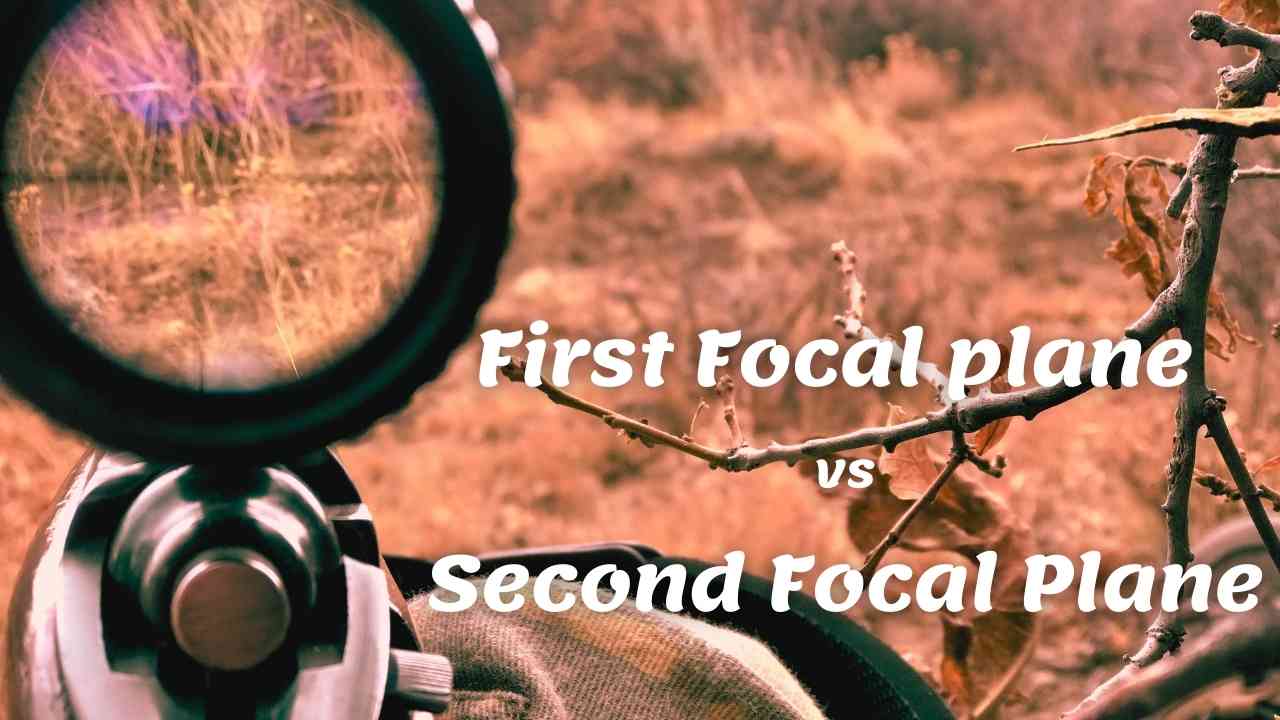
Most people want to make their shooting experience a memorable one. For this purpose, they do not just need to buy the perfect rifle but also worry about buying the most suitable scope to assist their rifle.
If you decide to get a scope for your rifle, the various available options will throttle you. There is a wide range of rifle scopes available in the market; the expensive one, the affordable one, the one with high and low magnification settings, and the list goes on. Similarly, there are different reticle options available with rifle scopes. The two different reticle placement options divide the optics into a first focal plane and second focal plane optics.
The concept of the focal plane is a little tricky to understand. This article is a first focal plane vs. second focal plane comparison. It shall explain the difference between the two scopes, their advantages and disadvantages, and who should prefer what.
What is a Focal Plane?
The reticle in scope is an important consideration. You can say a lot about a scope’s efficacy by understanding the working of its reticle. Also, a reticle that gives various options to play with is considered an appropriate one.
Now, you must be wondering what a focal plane has to do with a reticle. Here is the answer. The point on a glass tube on which the reticle sits is called the focal plane. The two types of focal planes in the debate are the first and second focal planes. The first focal plane reticle is different from the second focal plane.
ffp vs sfp
Difference between first focal plane vs second:
Before understanding the advantages and disadvantages of both the scopes, it’s essential to understand their fundamental difference.
In the first focal plane, the reticle’s size is variable, which means that the size of the reticle changes with the change in magnification of the scope.
You have a scope with variable magnification, with the reticle in the first focal plane. If you increase your magnification from 1X to 12X, the reticle’s size will increase.
The increase in magnification of the lens increases the size of everything placed in front of it. As the reticle, in this case, is placed in front of the magnification lens; thus its size also increases.
In the second focal plane, the reticle is placed behind the magnification lens, and the change in magnification does not change the reticle size. At any power setting, the reticle size will remain static.
You have a scope with a magnification range from 1x to 12x. The reticle size at 1x and 2x will be the same.
It is also important to note that the first and second focal planes matter when using a variable power scope. Because in a fixed power scope, the magnification itself does not change.
Hunters have been using second focal planes or SFP scopes for years. Its use is more common than an ffp as they are easier to manufacture and less expensive.
Why the relationship between the reticle and the target matter?
If you want to understand the pros and cons of using either focal plane, you need first to know why the change in the size of the reticle makes a difference in the efficacy of a scope.
We need to do many things with a reticle, such as determining the range of the target or determining the bullet drop. For essential considerations such as these, the relationship between the reticle and the target must remain static.
For example, you have to determine the bullet drop of your weapon scope; you need to have predictable and repeated performance; for that to happen, the hash marks on your scope must represent the same physical distance. When you increase the magnification of your scope, and the reticle does not increase in size, then this predictability is not possible.
Similarly, while you are trying to determine the range of the reticle and its size does not adjust itself with the increase in magnification, you will not measure it correctly.
First Focal Plane Scope
The first focal plane optics are relatively newer than the second focal plane. We have already established that the reticle changes with the change in magnification in the first focal plane. It is from this feature that you will understand the advantages and disadvantages of an ffp.
Pros
The most significant advantage of using an ffp is that the reticle remains in proportion with the target in view at all magnifications. Due to this, you can easily adjust the trajectory over long ranges.
The hash marks of the reticle remain accurate, enabling speedy target acquisition and more accuracy. You can accurately mark the reticle on the target at all ranges without making any adjustments to your scope.
It also works well with the scopes having BDC reticles. If you want to determine your scope’s range and bullet drop, it is easy to measure it with a first focal plane.
Cons
The downside of using an ffp is that the reticle becomes very small when used at a low magnification setting. It becomes hard to see and use. And if the light is low, it becomes even harder to view the reticle. Similarly, the edges of the reticle may become out of view when maximum magnification is on.
The ffp scopes are also higher in price because they are more challenging to manufacture, and shooters mostly use them with higher-end scopes.
Second Focal Plane Scope
Pros
The advantage of using a second focal plane is that the reticle remains at the target at all magnification settings.
Also, they are easier to manufacture and hence more commonly available. Because of the less complicated making, SFP scopes are also more affordable than ffp scopes.
Cons
In the second focal plane, the reticle has the same size at all magnifications. Consequently, the sub tensions of the reticle do not work accurately at every range.
It does not work for long ranges. When you use an SFP at a long-range, the measurement between the hash marks will vary at different magnifications. It requires a specific range for its reticle sub tensions to work correctly.
It does not work with scopes that have BDC reticles. For example, you have a rifle scope that has a magnification range of 4.5X-14X. Also, assume that at 4.5X, each sub tension( hash mark or a dot) will have an approximate 100 yards drop. When you change the magnification, the hash mark location on the target’s body will change. Your calculated bullet drop distance was 100 yards drop that will not be accurate anymore.
Also, it is not suitable to determine the target range as the relationship between the reticle, and the target is not static.
How to choose your scope?
Now you have all the information about the first and second focal plane scopes. You know their pros and cons. We, indeed, can not claim that one is better than the other.
Either you want to buy an FFP, or an SFP scope entirely depends on what you will do with it. The purpose of using your scope will determine your preference.
Who should prefer an FFP scope?
Those who want to use their scope for long-range shooting should prefer an ffp scope as they need to take quick shots and use holdover. Also, those who use high-powered scopes need to consider an FFP rather than an SFP. It is also a good choice when you require precision and extreme accuracy.
Who should prefer an SFP scope?
If you want to use low-power variable optics, then SFP is your choice. At low magnification, the reticle is bigger and hence faster. Shooters prefer an SFP scope for close-quarter shooting. Also, it would help if you used an SFP for hunting, as in ethical hunting ranges, you don’t need to worry about the bullet drop, and close hunting shots need bigger and quicker reticles.
An SFP is also a good choice for casual shooters due to its affordability factor.
Conclusion
In a nutshell, the main difference between a first focal plane scope and a second focal plane scope is the reticle placement. The reticle in FFP sits in front of the magnification lens. Due to its position, it changes with the change in magnification.
In an SFP, the reticle is behind the magnification lens. Due to this placement, the size of the reticle remains unchanged by the change in the magnification. It is from this main difference that all other features of both the scopes are derived.
But what determines your choice of scope is not the pros and cons of each focal plane but the buyer’s preferences. At long range, ffp works better; it is also preferable to use with high magnification scopes. It also gives precision and extreme accuracy. However, those using low-power optics should go for an SFP because its reticle is bigger and faster at low magnification.
Frequently Asked Questions
Which is better: the first focal plane or second focal plane?
It all depends on the purpose for which the hunter is using the scope. If you use your optic for long ranges and use holdover marks, an ffp is your choice. If you are a casual shooter, you are not shooting at any particular long-range; you can opt for an SFP.
Do Snipers use FFP or SFP?
The majority of the snipers use SFP scopes.
Which is better, FFP or SFP?
Between an ffp and SFP, the scope which suits your needs is better for you. The difference between the two is the placement of the reticle. Use an ffp for long-range shooting and an SFP when you are not shooting at a particular long-range.
What is the advantage of the first focal plane in scopes?
The advantage of a first focal plane is that the hash marks on the reticle remain in proportion with the target. Due to this, it allows more accuracy and speedy target acquisition.
Does the military use FFP or an SFP?
Military shooters prefer to use low-power settings, so they will like using a second focal plane.
Why are first focal plane scopes more expensive?
In the first focal plane scopes, the reticle sits in front of the magnification lens. Due to this complicated construction, an FFP is more expensive.
What should one consider while buying an SFP?
One should consider an SFP scope with adjustable elevation and windage turrets.
Does Vortex have ffp scopes?
Vortex offers various ffp scopes such as Diamondback Tactical 4-16×44 FFP, Strike Eagle 5-25×56 FFP, Viper PST Gen II 2-10×32 FFP, and Razor HD 5-20×50 FFP.
Does Leupold have second focal plane scopes?
Yes, most Leupold scopes are second focal plane scopes such as VX-3i, VX-5HD, and VX-6HD.
